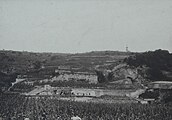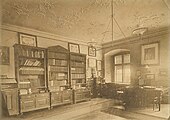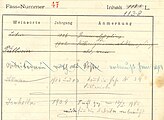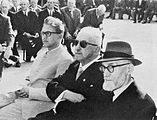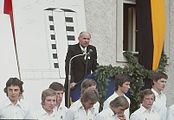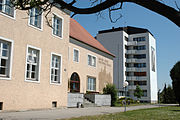Viticulture School Krems
| Viticulture School and Wine Management Krems | |
|---|---|
 |
|
| type of school | Agricultural College |
| founding | 1875 |
| address |
Wienerstrasse 101 |
| place | Krems at the Donau |
| state | Lower Austria |
| Country | Austria |
| Coordinates | 48 ° 25 '2 " N , 15 ° 37' 17" E |
| carrier | Province of Lower Austria |
| student | about 170 |
| management | Dieter Faltl |
| Website | www.wbs-krems.at |
The Krems wine and fruit growing school , usually just called the Krems wine growing school for short , is a vocational agricultural college in Lower Austria . It has the task of providing general and technical training to farm owners of wine and fruit growing businesses or all pupils interested in this special branch after the 8th grade and to prepare them for their profession.
history
At the public meeting of the Krems municipal council on May 13, 1861, the first suggestion was made to found a viticulture school. An exhibition of agricultural products carried out by the agricultural kk district association in Krems in 1862 gave additional impetus for the establishment of a "Krems fruit and wine school". On July 4, 1863, the first tree refinement course was held in the Schießstattgraben under the direction of Josef Seif . On September 28, 1863, the Krems Chamber of Commerce took the decision to found a viticulture school. On November 17, 1864, winter courses began in the then secondary school at Pfarrplatz No. 7 in Krems. Classes took place on Wednesdays, Saturdays and Sundays from 5:30 p.m. to 7:00 p.m. The municipal orchard and vineyard were used for practical lessons.
In 1870, due to internal differences, lessons had to be stopped despite the support of the city of Krems from Mayor Dinstl and Ritter von Wertheim .
1874 On October 14, 1874, the decision to found a regional wine school in Krems was passed in the Lower Austrian country house . This was preceded by the imperial resolution from 1874, according to which the Klosterneuburg state college , which had existed since 1860, was elevated to the status of a kk oenological and pomological institute. The Krems viticulture school is the successor to the Klosterneuburg winegrowers' school at the time.
In 1874 Franz Freiherr Ritter von Wertheim donated a cellar in the Krems town moat to the regional wine school, which was used until 1952 and then sold.
Franz Freiherr Ritter von Wertheim - sponsor and supporter of the Krems Wine School.
1875
On February 15, 1875, the first course was opened at the Krems winegrowing school. The reason for the establishment of scientific educational institutions in the 19th and beginning of the 20th century is to be found in the progress of the enormous scientific knowledge and in the fact that this knowledge could be used economically and should therefore be communicated to a wide range of people.
From the time it was founded until 1898, lessons were given in the elementary school on Hafnerplatz and until 1903 in the building at Pfarrplatz 7.
1877 In
1877 4 yoke areas - Ried Wachtberg - were purchased. The wasteland was converted into a terrace vineyard with great effort . Interesting finds were made during the work, including a skeleton and 30 gold coins from the years 1298 to 1332. In 1898 the first riparia seedlings were exposed and attempts at grafting began. In 1889 a large number of cut vines could be given up.
1889
First appearance of downy mildew .
1898
Heavy occurrence of oidium . In that year, the title of the school was also changed to the Lower Austrian State Wine and Fruit Growing School Krems .
1901
occurrence of phylloxera in Creams (Wolf trench), Stratzing and Tide .
1902 In
1902 7 Joch Grund was leased from Wilhering Abbey and a vine and tree nursery was established. This is today's vineyard area in the KG Landersdorf von Krems.
1903
From 1903 to 1950 the school was housed in the rooms of the Piarist monastery. In 1903 branch courses were held in Langenlois and Herzogenburg .
The need for wine advice was recognized very early on and a wine chemistry laboratory was set up.
1922
The school was run as a one-year school for 48 years. In 1922 it was converted into a two-semester winter school.
1923
Foundation of the graduate association .
In 1923 the regional vineyards and fruit orchards in Herzogenburg , Langenlois , Aggsbach and Spitz an der Donau were temporarily placed under the administration of the school.
1925
- 50th anniversary celebration
1935
- 60th anniversary celebration
At the 60th anniversary celebration in 1935, the graduate association gave the school an 18 hl barrel. The design of the barrel bottom carving was made by the sculptor Heiter from Krems, the work was carried out by the master binder Vogl from Stockstall.
1950
November 18, 1950 can be counted among the most important days in the history of the school. On this day, in the presence of the then Federal Chancellor Leopold Figl , the Minister of Agriculture Josef Kraus and many public figures on the occasion of the 75th anniversary, the new boarding school in Wienerstraße 101 was inaugurated by pastor Johann Schrimpf. This building was built on the initiative of Governor Johann Steinböck, who was also present, with funds from the state and the Marshall Plan . Since then the school has had its own school, boarding school and farm building.
The school had a close connection to Lenz Moser . Lenz Moser's knowledge and ideas were decisive for the start of mechanization, especially when Austrian viticulture began again after the Second World War . Annual school excursions to Rohrendorf to the Mosers company deepened this relationship. Back then, not all specialists shared Lenz Moser's new path. The breakthrough in the spread of high culture came in 1956 when many vineyards suffered severe frost damage after the severe winter. In many cases, instead of the usual stick culture, a high culture according to Lenz Moser was established, who wrote: It is inappropriate to adapt the machines to the vineyard, the vineyard must be adapted to the machine work . Since the high culture had withstood the severe winter frost of 1956 well, the winegrowers subsequently almost exclusively chose this educational system for new plants.
In 1950 the Lower Austrian “Rural Technical Schools” were renamed “Agricultural Technical Schools”.
1965
On September 18, 1965, the school celebrated its 90th anniversary.
Lenz Moser demonstrating how to cut a high culture stick.
1952
Completion of the farmyard. At that time, the farm included apartments for servants, a cow and pig sty. In the 1960s, other purposes were assigned to the premises.
1958
Today's small machine hall was completed and was the first facility for agricultural engineering training.
1969
The theory and practice taught from the beginning was first offered in one-winter and later until 1972 in the form of two-winter courses. In between there were some attempts to lead one-year courses; the last of this type were held in addition to the winter courses between 1966 and 1970 in order to remedy the acute lack of space at the time. Since after the introduction of compulsory agricultural vocational school, the pupils could only be admitted to the technical school after completing this school, it was obvious to create a type of school that simultaneously fulfills this obligation and continues with the technical school.
Two-year courses were introduced from 1969. They were run as 10th and 11th grades and required attendance at the polytechnic course or a school to replace it.
1972
Start of running three-year courses after the end of the winter courses and two-year courses. This type not only introduced an extended training period, but also created a new form of technical school training.
1975
- 100 years of the Krems Wine School
In 1975 the school celebrated its 100th anniversary. On the occasion of these celebrations, the clone of the Grüner Veltliner variety selected in the school's test facilities was handed over to the practice. He got clone No. 100 on the occasion of the 100 year anniversary. This clone is still widespread in all wine-growing regions today. It was examined for virus infections towards the end of the last century and is now offered as certified clone material under Grüner Veltliner A 1-2. Beginning with selective breeding soon after the Second World War, the school made a very important contribution to the productivity of Austria's most important grape variety. In addition to this clone, other very similar clones of the Grüner Veltliner variety were released, which showed better vitality and productivity. Essentially, this was achieved by selecting healthy, vital vines.
Provincial Councilor Matthias Bierbaum at the keynote address.
1976
1976 a training workshop with adjoining rooms for practical training in agricultural engineering and construction technology was built and opened on December 6, 1976.
1980
At the end of June 1980 the new boarding wing with dining room and kitchen was opened and the school building built in 1950 was rebuilt. The extension of the training period and the increase in the range of teaching materials were taken into account by expanding the space available. This also enabled the students to be prepared for the master’s examination in viticulture and cellar management in their home school.
1981
The first computers (6 pieces) are purchased for a class. Start of IT lessons.
1989
From 1989 the one-year special course "Wine Management" with a focus on marketing is offered.
1995
From the 1995/96 school year there is the "VinoHAK", in which the students complete their commercial training at the Krems Commercial Academy with a high school diploma and a professional qualification as a skilled worker for viticulture and cellar management at the Krems wine and fruit growing school.
2000
- 125 years of the Krems viticulture school
The school celebrates its 125th anniversary with a ceremony in the Dominican Church in Krems. On the occasion of these celebrations, partnership agreements were concluded with the teaching and research institute in Neustadt an der Weinstrasse (Germany) and with the Viticulture School in Rouffach (France). In addition to the professional exchange, the aim is to organize a student exchange with practical work places in wine-growing businesses.
2013
2013 the new competence center was opened. In addition to the systems for professional wine production and storage, it includes seminar rooms and laboratories for schoolchildren and for advice. The regional wines are sold in a corresponding tasting room. The Krems branch of the Federal Office for Viticulture (wine quality control) is also located in the new competence center. The immediate proximity to the Krems District Chamber of Farmers has created a concentrated education and advice center for the region.
School directors
School profile and offers
The Krems Viticulture School is a teaching, training and advisory center for viticulture and fruit growing, cellar management and wine management.
Various training options are offered for this purpose today:
-
Technical school - is the standard form. It is a 4-year technical school and consists of 3 modules.
-
- Module 1: Basic knowledge in regional viticulture and fruit growing.
- Certificate: Completion of general compulsory schooling - Compulsory vocational schooling.
- Module 2: Comprises compulsory internship at home and / or abroad and the subsequent operations manager course.
- Certificate: skilled worker for viticulture and cellar management or skilled worker for fruit growing; Middle school leaving certificate.
- Module 3: Entrepreneur and master craftsman course.
- Certificate: Viticulture and Cellar Master
-
- VinoHAK - commercial vocational training at the Krems Commercial Academy with high school diploma and a technical qualification in viticulture and cellar management at the Krems viticulture and fruit growing school with a skilled worker examination.
- Wine management - one-year special course with a focus on wine marketing.
Lesson subjects
The change in the timetable between 1904 and 2011.
| 1904 |
|---|
| Arithmetic, geometry and drawing |
| Viticulture |
| Cellar economy |
| Fruit growing |
| Culture pests and their control |
| Botany |
| Soil gauge |
| Natural science |
| beekeeping |
| Animal breeding and veterinary medicine |
| Practical use: WB, KW, OB |
| 2011 |
|---|
| religion |
| rhetoric |
| Political Education and Legal Studies |
| movement and sport |
| ecology |
| Business administration and accounting |
| Marketing and Economics |
| Information technologies |
| Mathematics and technical computing |
| English 1) |
| Crop production |
| Agricultural engineering and construction |
| Viticulture |
| Cellar economy |
| Wine presentation |
| Wine and food |
| Fruit growing |
| Practical lessons in WB, KW, OB, LT. |
| Marketing major |
1) English is taught as a compulsory subject and French and Italian as an optional subject.
Affiliated institutions
public relation
The school has been linked to the practice since it was founded, as it was predestined for advice on major economic, viticultural (occurrence of phylloxera, downy mildew, oidium, etc.) and cellar management problems. The school's teachers have always had close contact with the region's winegrowers. They are not only helpful for telephone information and in the wine chemistry laboratory, but are also available for specialist presentations.
School and trial operation
For the training of the students and for experimental purposes, the institute operates its own winery (Lower Austria Landesweingut Krems) with 15 hectares of vineyards, a 3 hectare orchard as well as a vine nursery and a winery.
Development of school operations:
- 1875 Press house and cellar in the city moat - donation from Franz Freiherr Ritter von Wertheim .
- In 1877 under Dir. Schellenberg 4 Joch Ödland von Schulz and Sackur from Berlin were bought for 3000 guilders. The experimental vineyard "Wachtberg" was laid out on this wasteland.
- In 1902, 7 Joch Grund in the KG Landersdorf (municipality of Krems an der Donau ) was leased from Wilhering Abbey and a vine and tree nursery was established.
- 1938 Acquisition of the Lilienfelderhof, the Bründelgrabenkeller and Weingartengrund in the "Sandgrube" vineyards and in the "Marthal".
- 1949 Basic exchange between the municipality of Krems, the Benedictine monastery of St. Peter and the viticulture school for a piece of land in Wienerstraße (in “Thalland”) for the new school. This area is now the location of the viticulture school.
- In the period from 1977 to 1985, the school lost larger areas of land due to the construction of the expressway in the direction of Gföhl, in the school area and in the vineyards Sandgrube and Marthal, which were only partially offset by the exchange of land.
Wine chemistry laboratory
From 1903, when the school moved into the premises of the Piarists, a wine chemistry laboratory was available both for the pupils and as an advisory laboratory for the winemakers. The beginning was very easy and only with the new building in Wienerstraße was better equipment possible. In the course of the renovation of the building in 1980/81, the wine chemistry laboratory was significantly enlarged to become a student training and consulting laboratory.
Vine protection service
From the 1960s onwards, the Lower Austrian Chamber of Agriculture set up a vine protection service together with the winemaking schools of Lower Austria. With the enormous technological and scientific knowledge it was necessary to inform the winegrowers regularly during the growing season about the occurrence of diseases and pests and their control options. Initially it was only written mailings to the heads of the winegrowing associations or communities where the notice was posted on boards, today practically all winegrowers are provided with this information in writing or electronically (e-mail, website vine protection service). A network of weather stations serves as a support, via which winemakers can inquire about the current weather data or call up forecasts regarding the risk of certain diseases or pests occurring. All facilities serve to give the winemakers assistance in optimizing their treatment measures. The Chamber of Agriculture appoints a vine protection area manager for this purpose; for Krems it was Hans Altmann from 1963–1985, Karl Bauer from 1985–2010 and from 2010 Erhard Kührer.
Alumni Association
With the establishment of the Absoventenverband in 1923, an important link was created between the school and its graduates. The association provides information on current school activities with its own circulars and is a bridge to further training and advice. Together with the school, he organizes courses and excursions and is a non-bureaucratic, financial supporter of the school.
In 1935 the graduate association donated a goblet. A sip of wine (it must be a Riesling from the Wachtberg vineyard ) seals the official admission to the graduate association when certificates are distributed.
Name plaque with the names of graduates who in World War I died.
The chairmen of the association:
See also
- Vocational middle school
- Higher federal college and federal office for viticulture and fruit growing
- LAKO
- Further training opportunities for viticulture and cellar management
Web links
- Website of the Weinbauschule Krems / D.
- Vine protection service website.
- EUROPEA - The network of agricultural educational institutions in Austria.
- Website of the Handelsakademie Krems an der Donau.
- Website of the Agricultural Coordination Office.
- Service Center Rural Areas (DLR)
- Viticulture School in Rouffach-Wintzenheim in Alsace ( Memento from February 12, 2015 in the Internet Archive )
- Website of the higher federal teaching and research institute for viticulture and fruit growing, Klosterneuburg
Individual evidence
- ↑ Ferdinand Adam Dinstl jun .: Accountability report from Mayor Dr. Ferdinand Dinstl on the effectiveness of the municipal council during the last electoral term. Presented at the meeting on July 11, 1876. [1]
- ^ Franz Jachimowicz: Half a Century Agricultural State College Krems a. D. 1875-1925. Reprint of the Land-Zeitung, 46th year 26th Sept. 1925, printed and published by Josef Faber, Krems. [2]
- ↑ 60 years of agr. State educational institute Krems. In: Kremser Zeitung. Volksblatt for town and country. 66. Vol. 13, March 28, 1935, printer and publisher Josef Faber, Krems. [3]
- ^ Agricultural college Krems (ed.): Festschrift on the occasion of the 100th anniversary of the Krems viticulture school 1875–1975. 1975.
- ↑ Hans Frühwirth: Your love was for Krems. Culture Office of the City of Krems, 1997, communications from the Krems City Archives, Volume 29. ISBN 3-90-1664-01-9 , pp. 242–248.
- ^ Lenz Moser: From stake culture to high culture. Festschrift 100 Years of the Krems Wine School 1875–1975, 50 Years of the Graduate Association, pp. 64–65, publisher of the Krems Agricultural College.
- ^ Johannes Brückner: The Lower Austrian School System 1945 to 1990 , Verlag Niederösterreichisches Pressehaus, 1991, p. 193.
- ↑ Friedrich Walterskirchen: Steep ascent of the Krems viticulture school. The winemaker, no. 7/1980.
- ^ Hans Altmann: Greetings from our graduate association. Festschrift for the 100th anniversary in 1975, published by the Agricultural College Krems, pp. 90–91.





